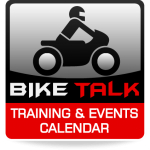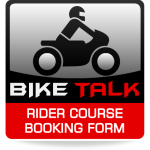It’s 7 am Monday morning and you peer out your bedroom window. Although the weatherman on TV had announced the night before that clear skies were in today’s forecast, dark grey rain clouds are looming in the distance. While sipping on your coffee, you try to estimate just how soon they’ll be hovering over your house and contemplate thoughts such as, ‘If I leave now, maybe, just maybe I’ll be able to make it without getting wet.’ After all, that shiny bike of yours, sitting in the garage all night is begging for you to take it for another spin. You glance back up at the clouds and decide that yet again, you will chance it and ride.
How important is pre-trip planning for bad weather riding and how do you do it?
The odds are if you ride long and far enough, sooner or later you’ll be confronted with bad weather, willingly or not. It could start off as a clear day, but then turn ugly and huff and puff you around the next corner. Taking into account experience, skill, preparation and risk tolerance, riding in rain or seriously bad weather should be avoided at all costs. However for some, riding a motorcycle in the rain can be anything from frightening to fun.
My planning involves attitude relaxed (check), good tyres (check), all weather high visibility gear, boots, gloves and rain suit (check), visor coated with anti-fog and water repellent (check). As for the route, fuel stops and rest breaks – nothing different to a normal day’s riding.
Preparing for any ride is important, but if you know you are going to hit bad weather and have no other choice but to head to it, then following are a few pointers that’ll get you through it.
Are there any pre-trip bike inspection and maintenance that becomes more important when faced with bad weather?
First of all I make sure my motorcycle is in good operating condition, especially the tyres as they are your first point of contact to the road, so they better be good. If I have to mention a brand here, with excellent road holding for bad or wet weather, then allow me to recommend Michelin Pilot Road 3.
Apart from the normal pre-ride inspection, let me not assume every rider conducts one, the primary focus has to be on lights, tyres, shocks and brakes. Lights for visibility: check that all the lights work, tail and brake light, indicators, and headlights. Get into the habit of riding with your main beams on, especially in low visibility conditions. Tyres should have a good tread depth and preferably suitable for wet weather riding or water displacement for traction. Just like bad shocks will give you poor road holding, multiply that effect for wet weather. These days most bikes come fitted with ABS and Traction Control, and although these are good to have, there are still motorcycles out there without these options. Brake pads and discs should be check for wear, have them checked and get your motorcycle brake lines bled before the ride.
What are the most common types of accidents in bad weather?
There are three types that stand out above the rest and these are: speed, following distance and surface. A typical situation is when you’ve been riding in dry weather, when all of a sudden you hit rain and the transition from your dry to your wet riding style takes too long. In other words, you are still riding at the same pace, following other traffic at the same distance, and not realizing you are riding on a more slippery surface soon enough.
You need to be able to change your “riding cap” in the same way as the weather changed: Quickly!
Immediately slow down! Immediately increase your following distance! Immediately pull over under a bridge or stop at a fuel station, and wait 30 minutes for the muck to float to the surface and washed away by general traffic or more rain, then get back in there. Stay off painted lines, manhole covers or anything that will jeopardize traction.
What are the most important riding techniques to be aware of in bad weather?Naturally, on wet roads lowered speeds, and careful movements are the watchwords. Keeping a relaxed body, and not a death grip on the bars also lets the bike do its thing. Progressively use the brakes. Take turns and accelerate smoothly. Going up a gear can help prevent spinning the rear wheel.
What do you need to know about safe riding in?
- Thunderstorms: It is not advisable to ride if you are where lightning is striking. Riders have been killed or knocked unconscious while riding in lightning. The lucky ones wake up in a ditch.
- Bitterly cold, snow or ice: Forget about riding in these severe conditions all together.
- Strong winds: A motorcycle is like a little sail. Full fairings and lighter bikes are especially susceptible to side winds. Be prepared to have to lean into the crosswind just to stay upright. But if leaning into the breeze, also be ready to compensate if the crosswind abruptly stops. Alternately, some riders have been known to parallel cars or larger vehicles to let them block extreme crosswinds. Be careful not to ride in anyone’s blind spot though, if you try this.
Is there anything special that you need to consider when riding with a passenger?
Do the math; some pillions weigh 50kg, others weigh 100kg. Putting extra weight on the motorcycle will affect the handling. Adjust your suspension and tyre pressures to compensate for the amount of company you’ve brought along. Realize that your braking capabilities have changed; take that into account. The more weight you have on the motorcycle, the longer it takes to stop but it will help get more rubber down fro traction.
How important is the personal protective clothing in bad weather – is there anything else you will be wearing changing from normal weather riding?
A always pack a rain suit when going on a long trip where there’s a good chance of rain, but a few years ago opted for a good all weather jacket with a wet/winter lining and a pair of Easy Overs from Xkulcha. A quality pair of all- weather boots to keep your feet dry, and the same goes for a pair of gloves. Now these items just keep the water out, you still have to deal with hypothermia and here I suggest you get yourself an open-ended tube scarf to keep the cold from creeping in at the neck area, a thermal vest and thermal underpants if you like. Don’t forget the thermal socks if you must.
There are vast amounts of all weather gear on the market, but I prefer to use those items that can adapt from the one to the other weather condition without having to carry or wear two of each. A simple but clever modular system is more than you’ll need in South African weather conditions.
How important is experience in bad weather riding conditions – are there any specific areas the novice rider should rather avoid in bad weather, or training he can do to be better prepared for bad weather riding?
A lot about how your rain riding experience goes is up to you. If, however, you are caught in a situation you feel is too much to handle, find the nearest safe spot to pull over. Otherwise, proactively teaching yourself to ride in the rain pushes back your fear threshold. Panic is the common denominator of all sorts of rider-induced crashes, so thinking about what you are doing, learning as you go, and not riding beyond the capacity of you or your motorcycle is key.
Any additional info you deem to be important for riding in adverse weather conditions?
By trying out a few options in bad weather closer to home, and sorting out any issues, could make the difference between surviving a longer trip and hating every minute of it.
Keep your vision and visibility clear: Hi-visibility colours and reflective bits are better than black or neutral colours without reflection. If you fell on the road, you would want to be easily identifiable as a human, not a piece of dirt bag. Treat your helmet visor with ATG (All Terrain Gear’s) Anti-Fog and Water Repellant coatings, and laugh at the buckets of water the weather might be throwing at you.
This has been an interview by Johan Jonck of Arrive Alive













